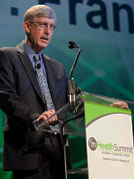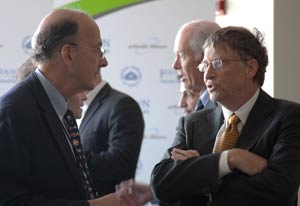Mobile health innovations advance research
November/December 2010 | Volume 9, Issue 6

Photo Courtesy of
Foundation for NIH
NIH Director Dr. Francis S.
Collins gave opening remarks
at the 2010 mHealth summit.
Innovations in mobile communications continue to drive advances in medical research and health care as private corporations, governments and foundations make substantial investments in the nascent technologies. More than 2,000 scientists, physicians, health researchers, software engineers, policymakers and telecommunications executives convened recently at a three-day mobile health - or “mHealth” - summit in Washington, D.C., to exchange views, share findings and discuss the future of the dynamic new tools and applications.
The meeting, presented by the Foundation for the National Institutes of Health in partnership with the mHealth Alliance and NIH, hosted 149 exhibitors and included representatives from 48 countries. It also featured a series of panel discussions and breakout sessions, as well as several prominent keynote speakers including NIH Director Dr. Francis S. Collins, Microsoft co-founder and Chairman Bill Gates, United Nations Foundation Chairman Ted Turner and U.S. Chief Technology Officer Aneesh Chopra.

Photo Courtesy of Foundation for NIH
Fogarty Director Dr. Roger I. Glass greets Bill Gates, who
was a keynote speaker at the summit.
The new field promises “a growing opportunity” both at home and abroad, Collins said, citing NIH-funded projects like a wearable chemical sensor for hydrocarbon exposure deployed in the Deepwater Horizon oil spill, a real-time monitoring system being used in Uganda to track adherence in HIV antiretroviral therapy and the popular MedLine Plus Mobile application developed by the National Library of Medicine. “Most NIH institutes have significant investments in mhealth,” he said. "It's time to take advantage of the marriage of mobile technology and research.”
Much of the enthusiasm at the summit surrounded the proliferation of mobile health applications in low- and middle-income countries, which are rapidly outpacing the U.S. in the use of the new health technologies. “Middle-income countries like China, Thailand, Mexico and Brazil are where most of the innovation will happen,” said Gates. “These are the places where things will work first.”
OpenMRS, an electronics medical records management system that evolved from a Fogarty-funded program in Kenya, is now supported by the Rockefeller Foundation and is utilized in scores of countries. Text messaging as a health intervention has also proved to be quite effective in low-resource settings. Text messages were a valuable tool in directing victims to clinics in Haiti immediately following the quake in early 2010, and cell phones are now being used there to track the ongoing cholera epidemic.
Though many scientists and physicians who had spearheaded successful pilot programs presented at the summit, much of the discourse that took place in the panel sessions concerned challenges being faced by health workers who employ mobile health applications in the field. Interoperability and scalability issues often hinder the implementation of programs, despite them functioning successfully in the pilot stage. “It’s easy to fool yourself into thinking something works,” said Gates, commenting on the need for pilot programs to be scalable.

Photo by Brian DeRenzi, courtesy of Harvard University
NIH is funding numerous mobile health programs across the
globe, such as this project that uses electronic protocols to
improve patient adherence.
The lack of infrastructure and working business models was another recurring theme. Dr. Judith Rodin, Rockefeller Foundation president, pointed out that without these essential supporting elements, mobile health devices are merely clever gadgets or novel examples of high technology. “We need recombinant innovations, people putting things together in a new way,” she said. “Invention is not enough.” Rodin used the example of the first cell phone call - made in 1973 - to illustrate this point. It would be decades before the telecommunications industry built an adequate infrastructure to support widespread use of mobile phones.
Privacy and ownership of patient data were also on the minds of many of the attendees. Many of the new mobile health programs are based on cloud computing platforms, which are internet-based and are thought to be less secure than server-based applications. Additionally, proprietary software can create problems in developing countries, where cash-strapped ministries of health are sometimes unable to maintain applications or ongoing license fees. One panelist pointed out that in some of these cases software manufacturers have confiscated large amounts of vital patient data along with their applications, potentially putting patients at risk.
Difficulty in changing human behavior was repeatedly identified as an obstacle to implementation of the new applications. “It’s not enough to just give people cell phones,” said Dr. Walter Curioso, a Fogarty grantee who has carried out several large-scale cell phone-based studies in Peru.
Other panelists surmised that older patients will be less likely to adapt to the new devices. Similarly, overburdened physicians and health workers might also have difficulty taking on a new technical skill set. “Immunization is easy,” said Dr. Linda Wright, director of Global Network for Women's and Children's Health Research at National Institute of Child Health and Human Development at NIH. “What is really hard is changing human behavior and management.”
Some experts also voiced concerns about the low literacy levels of some of the populations targeted by health technologies that employ text messaging as the primary means of communication. The need for education or the use of visual messages in certain cases was proposed by a few of the attendees. “Know your customers,” said Dr. Nils Daulaire, director of the HHS Office of Global Health Affairs. “If we understand their needs, their realities and their limitations - which includes in many cases the inability to read the text on their text messages - then I think we’ll be better serving their health needs.”
Despite these concerns, there was cause for optimism. “We have a robust research agenda and we’ll need new business models and behavioral changes that will work,” said Fogarty Director Dr. Roger I. Glass, who delivered closing remarks. “But the path ahead is bright, with many opportunities.”
More Information
To view Adobe PDF files,
download current, free accessible plug-ins from Adobe's website.